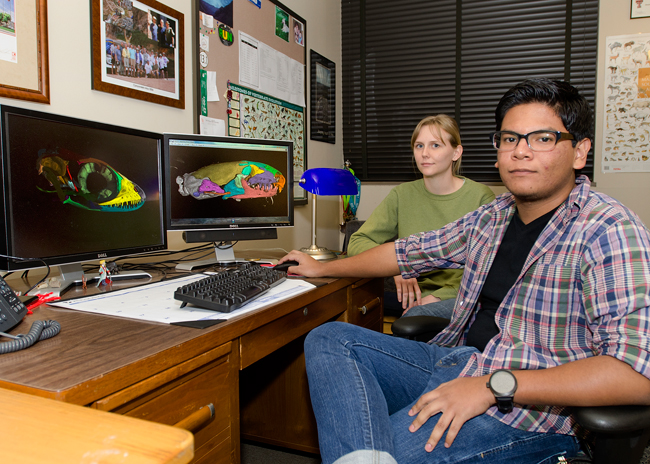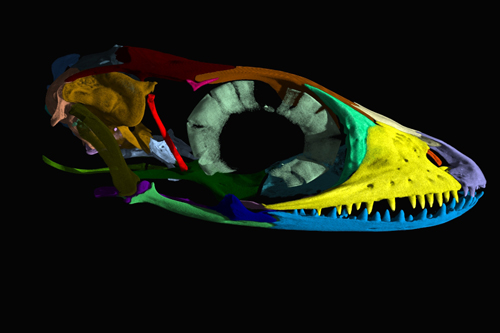Junior Excels In Biology Lab With Big Plans To Study Tiny Organisms
Jan. 30, 2013
SHSU Media Contact: Jennifer Gauntt
Story By: Kim Morgan
 |
| Cristhian Cadena (right) and classmate Beth Horstman are two of Patrick Lewis's biology students working on his research with the amphisbaena lizard genus, originally collected in Africa's Republic of Botswana. The research team, led by Cadena, examines CT scans of the species of lizard that measures less than an inch long and has no limbs, attempting to identify all of the bones in the cranium. Their work has resulted in the image on the right computer monitor. Cadena is conducting a similar study on the lygodactylus genus, also known as the dwarf gecko, as seen on the left-hand screen. —Photo by Brian Blalock |
Growing up in Colombia, Cristhian Cadena was just a young man when he realized the country's education system couldn't take him as far as he wanted to go. So he dreamed of coming to the United States, something that came true when he was 16.
Now, just six years later, the 22-year-old is a junior biology major at Sam Houston State University. Not only is he a first-generation college student, he's planning to take it all the way to a doctoral degree.
Cadena is a member of SHSU's Elliott T. Bowers Honors College and is also a McNair Scholar, a program that provides talented, first-generation undergraduates with effective preparation for doctoral studies. In his pursuit of a Ph.D., Cadena already has presented at four conferences and turned down a Vanderbilt University internship last summer to go to the Ivy League University of Pennsylvania program, where he worked for three months in a viral immunology lab. The research from that project resulted in his winning an award for best presentation at the Annual Biomedical Sciences Conference for Minorities in San Jose, Calif., last November.
Throughout all of this, Cadena says he's keeping his options open because he's not sure exactly what he wants to be when he “grows up.” He's interested in biological systematics, which is the study of diversification of living forms, but he's also interested in biomedical sciences. There's no doubt, though, Cadena is wearing as many hats as possible while he figures this all out.
Back at SHSU, Cadena splits his time between researching plants and, well, obscure lizards; two genera of lizards, to be exact.
The first project, with associate professor of paleobiology Patrick Lewis, studies "tiny, itty-bitty" skulls of the amphisbaena lizard genus, one that was found on an expedition to the Republic of Botswana, in southern Africa, in 2009.
In the other, his McNair thesis project, Cadena is examining the lygodactylus genus, also brought back to the U.S. from Lewis’s Botswana expedition.
For both projects, Cadena is doing what Lewis calls “basic anatomy: describing specimens and individual bones, looking for variation.
“It plays into how well we understand the boundaries in between species, what’s a real species and what isn’t, which is a real biological problem,” Lewis said. “A lot of species are defined based on anatomy, so we’re trying to see how fuzzy that anatomy is, what sort of characters separate one species from another.
“These just happen to be particularly poorly known groups, so conservation plays into it. Are they new species; are the endangered? We don’t really know until we can identify who they are and what they do,” he said.
"Only a few people work with these lizards, so there are only a few descriptions on them," Cadena added. "The work we're doing will add to existing explanations."
 |
| Cadena's McNair scholar thesis is concerned with identifying the bones in the cranium of the lygodactylus genus of lizard, as seen in the CT scan image above, which has identified most of the bones with a color-coding system. The study will help scientists classify the "obscure" genus of lizard, which was collected by Lewis in 2009 in Botswana. |
Both cranial anatomy projects require Cadena to examine CT scans that are blown up and animated to better display the anatomy. The scans, taken at the University of Texas on a high-resolution CT scanner, produce incredible details that allow the researchers to see things they wouldn’t be able to, using a traditional anatomical approach because of the size of each genera of lizard.
“The lygodactylus genus is called a dwarf gecko because it’s so small. They are 5 centimeters from the tip of the snout to the tail,” Cadena said. “It’s nearly impossible to do anatomy on a gecko this small by hand, so CT scans are really the best technology for that.”
While there are six to eight students working on the Lewis project with the amphisbaena lizards, Cadena has been a key player in launching the CT aspect of the work. He oversees the work, makes sure everyone is trained and keeps everybody organized.
“Cris has his hands on all the CTs in the lab,” Lewis said.
"He's that rare combination of really smart, a really hard worker, and passionate about his research," he said. "I'll leave at 7 at night and come back at 7 in the morning and he's still in the lab working. He doesn't seem to need sleep for some reason."
It must be pointed out that some lizards are nocturnal; perhaps Cadena is just really at one with their basic biological functions.
Or he just really, really likes the work.
"When it's a passion," Cadena said, "it doesn't seem like work."
When Cadena first arrived at SHSU, he was a philosophy major, during which he took a general psychology class. Nestled in one of the textbooks was a chapter on neuroscience. Cadena was curious, so he took a couple of biology classes. Then he was hooked, so he changed his major.
Since then, he's become an unpaid teacher assistant in Lewis's department. Lewis said he would be hard-pressed to find a student who doesn't see Cadena as role model.
Elisabeth Horstman, a senior with a biology/geology double major, is one of them.
"Cris is an admirable student and always produces great work even when the assignment is trivial," Horstman said. "It's obvious he really enjoys research. And anytime you ask him questions about what he's studying, he gives really in-depth answers."
At the end of February, he will present at the Texas Academy of Science annual meeting in Kerrville, and this summer he will present at a national conference in Albuquerque, N.M., titled the “Joint Meeting of Ichthyologists and Herpetologists.” Though he’s a seasoned presenter, he admits that it’s always a little scary.
"It's always intimidating when you're doing a national conference," Cadena said. "Those people actually know what you're talking about."
Cadena admits he "definitely" gets nervous before a presentation, but he deals with the jitters like a well-trained researcher—keep at it until it comes out right.
"I'll go over it again and again, to anyone who is in the room," Cadena said. "They probably get bored."
A good night's sleep helps too, Cadena said, which takes us back to his nocturnal hours in the lizard lab—and to a future where the world is his oyster.
"Cris is, without a doubt, the best student I've seen in the biology department in seven years," Lewis said. "He's really smart and he works really hard."
- END -
This page maintained by SHSU's Communications Office
Associate Director: Julia May
Manager: Jennifer Gauntt
Located in the 115 Administration Building
Telephone: 936.294.1836; Fax: 936.294.1834
Please send comments, corrections, news tips to Today@Sam.edu.

 SamWeb
SamWeb My Sam
My Sam E-mail
E-mail

